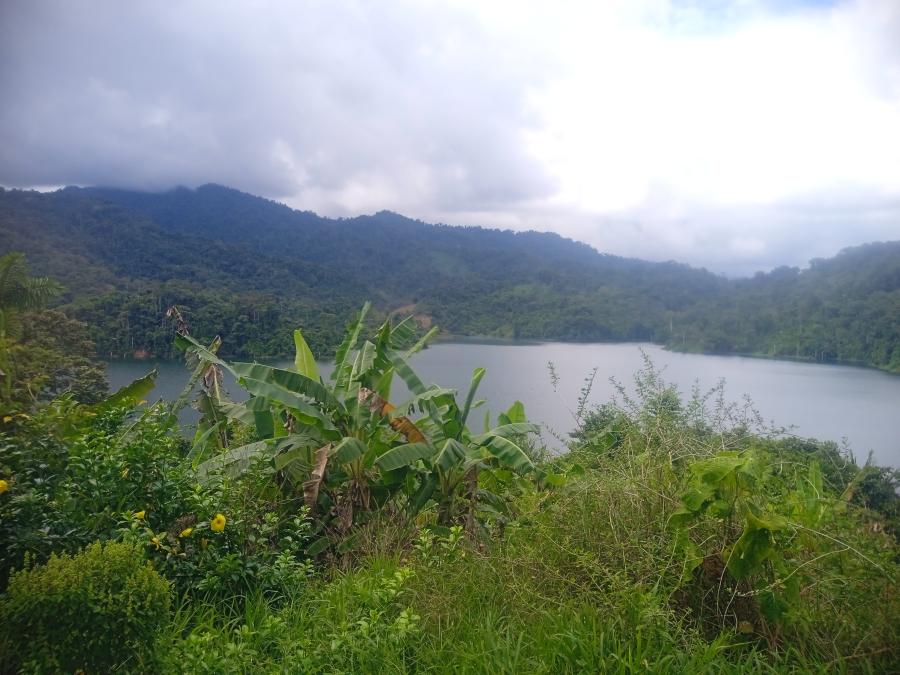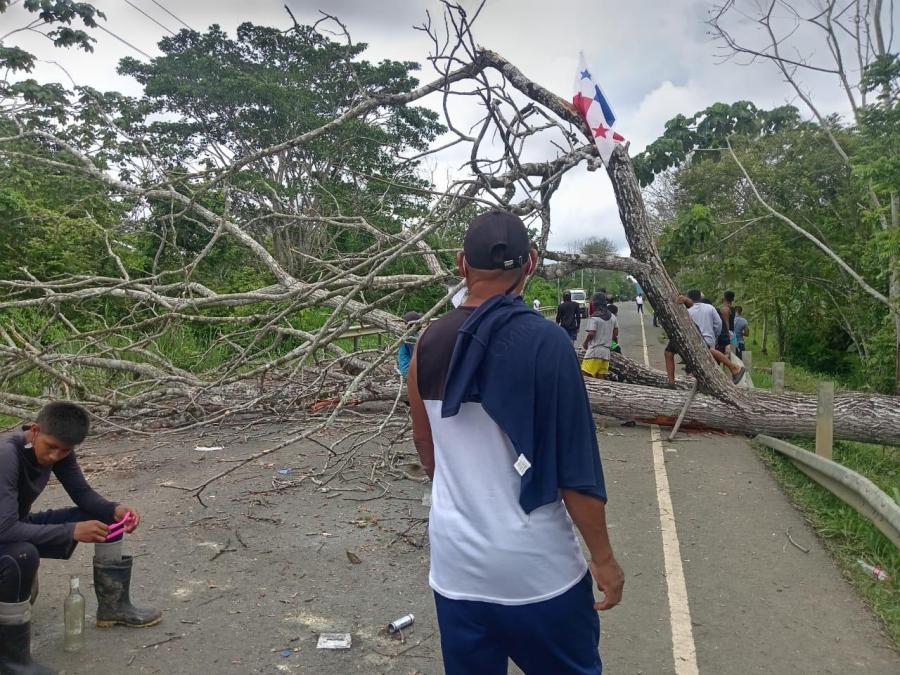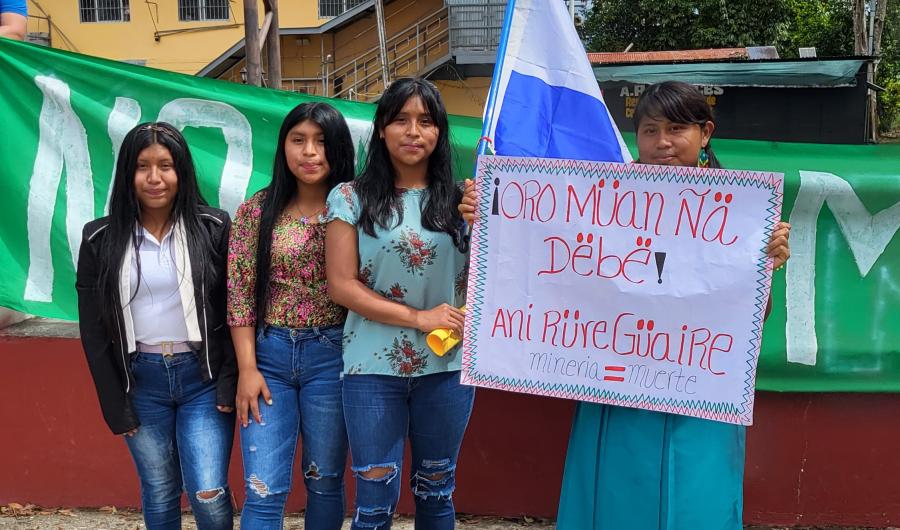The Kuna people live on Panama's northeastern Caribbean coast, and their beautiful lands (which they call Kuna Yala, known to others as San Bias) draw many visitors. Their reservation, or comarca, consists of a strip of the mainland and about 400 islands. With sandy beaches, clear water, coral reefs, and sunny skies, Kuna Yala seems like paradise to tourists. According to the Panamanian government's Tourism Development Master Plan,
San Bias is the most important resource Panama has to exploit…[Yet] the Kuna natives pose [an] obstacle, as they wish to do everything by themselves or with outside assistance only on their own terms.
The Kuna General Congress' (CGK) Statute on Tourism in Kuna Yala is the latest determined effort by the Kuna to define their own terms for interaction with outsiders and gain a measure of control over the burgeoning tourist industry. Ratified in 1996, the Statute has established guidelines governing all aspects of tourism in the comarca and represents a carefully planned strategy to direct the tourism industry to the needs of the entire Kuna nation. The Statute represents a remarkable effort at self-determination by an indigenous people facing a $10 billion industry that sustains more than one in ten jobs around the world. The Statute's goal is to help the Kuna make some badly needed money while minimizing the problems that visitors bring along with their cash. Due to widespread tax avoidance and unregulated cruise ship traffic, however, the Kuna have been only partly successful in their efforts. Improved enforcement of the Statute is urgently needed. To increase compliance, the Statute must be publicized among the international tourists who visit Kuna Yala.
The Kuna
Of the more than 47,000 Kuna people in Panama at the time of the 1990 census,(1) almost 32,000 lived in the 49 communities of Kuna Yala. Since their 1925 uprising against the central government, they have gained a significant degree of self-rule -- much more than other indigenous peoples of Central America. The Kuna gained their comarca in 1938, and the Panamanian constitution of 1945 vested most decision-making powers therein to the Kuna General Congress (CGK), a body made up of democratic councils attended by delegates from all Kurta communities, who in turn elect an executive body of three leaders. The Panamanian legislature, however, can pass laws to subject Kuna Yala to special governance, to effect public service, or to make administration easier, and 16 such laws are in existence. Through these and other means, the Panamanian government has tried to integrate the comarca into the rest of Panama and has won certain battles -- most notably those regarding primary education, customs inspections, and malaria spraying, all of which the Kuna have opposed for various reasons. Still, according to James Howe, the precise terms of this integration are "as much Kuna- as government-inspired." The Kuna remain isolated, largely self-sufficient, and proud of their vibrant traditions.
Although they are more politically independent than many other indigenous peoples, their poverty is quite typical. The Kuna are poorer, hungrier and sicklier than other Panamanians -- who are themselves quite badly off. According to the Panamanian government, for example, the monthly basket of basic necessities costs $200, yet the average monthly income in Kuna Yala is $75. At 60 per 1000, infant mortality is more than twice that in the rest of Panama, and the rate of child malnutrition is the highest in the country: 71.1 percent. The Kuna need money to buy medicine, schoolbooks, and food -- as well as such necessities as building materials, tools, and boat engines. A central question for Kurta leaders, then, is how their people can augment their incomes while maintaining their hard-won autonomy and cultural distinction.
The Statute
The Statute is intended to mitigate three of tourism's primary effects: exploitation by non-Kuna, labor shifts, and competition (inter- and intra-community) for tourist dollars.
Tourism in Kuna Yala has grown dramatically since the 1970s, and until recently was most often under the control of ladino (non-Indian) Panamanians, for whom the Kuna usually worked as menial employees. Resentment of the profits sent back to Panama City led to the passage of the Statute. Its goal is to help the Kuna make money from tourism while minimizing its negative effects. According to the first Article,
The only tourist activities and infrastructures possible in Kuna Yala will be, strictly and solely, those that respect, conserve, value, and defend the natural resources, environment and biodiversity of the comarca, as well as the sociocultural, political, and religious Kuna norms and customs.
The tourist industry has not complied with this stricture, and probably could not do so even if it tried. Instead of attempting to enforce this Article closely, the CGK has tried to achieve the same objectives by limiting the number of hotels and restricting ownership of all tourist facilities to Kuna. Articles 2, 6, 51 and 52 of the Statute establish that all Kuna must apply to the CGK for written permission before undertaking any tourist venture; those who do not comply will have their property confiscated. The CGK has not approved any new hotels since the Statute was passed, but there are persistent rumors of black market hoteliers.
According to members of the CGK, these limitations on tourist ventures are designed to reduce the movement of labor from traditional occupations to the tourist industry. The labor transfer thus far has resulted in a significant loss of culture. Women now mass-produce cheap molas (the colorful, decorative, layered cloths popular among tourists) that depart from traditional styles; those Kuna with access to tourist dollars often receive more community respect that the traditional political leaders; and Panamanians often criticize Kuna for being too shrewd and worldly.(2) More practical difficulties have resulted as well. One Kuna told a reporter from La Prensa that agricultural workers "don't plant yuca, plaintains or guineos anymore because they are just waiting for the cruise ship." A CGK official explains: "When the tourists did not come, and we did not have the sorts of agricultural products that we needed, it became obvious that there was too much of a shift from agriculture to tourism." By restricting the number of hotels, the CGK hopes to reduce the jobs available in the tourist industry, thereby protecting traditional Kuna culture and economy.
The Statute also addresses competition between existing hotels and communities over tourists. The fear is that competition will become open conflict; one prosperous Kuna hotel owner called this "the real danger." Members of the CGK executive body reported in several interviews their satisfaction that hotel owners are making no more money than others in the communities. Given that hotels sometimes charge as much as $250 per night, however, with the majority charging about $100, it seems clear that hoteliers are in fact earning much more than those who fish or harvest plaintains. An editorial in CGK periodical Yala highlights hard feelings about such disparities. The anonymous author complains that although some areas visited by tourists "generate great quantities of quantifiable income, these profits are not distributed equally, but rather...benefit a few rich people." The Statute attempts to ensure that the entire comarca benefits from visitors' money. Article 13, for instance, declares: "Each community location of tourist activities will [effect]...a just distribution of goods between inhabitants of the community and neighboring villages." Similarly, according to Article 17, "The local community or those affected directly or indirectly as tourist areas may demand participation in the benefits that tourism creates. The Tourism Commission will arbitrate each case in coordination with those directly responsible." While the distribution of profits from tourism is imperfect, the Statute provides a formal commitment to equity and a mediation procedure for those claiming they do not receive the benefits to which they are entitled.
Non-Enforcement
The CGK collects tax revenue from tourism -- in part to distribute the proceeds among other Kuna communities -- but does so ineffectively and inconsistently. The administrator who handles tax accounts reports that each hotel is supposed to pay $1 per tourist. The CGK began keeping computerized records of these receipts only in 1996, and the revenues from tourism are clearly underreported. Evasion of taxes by Kuna hotel owners is common and has been the subject of several articles in La Prensa. A close inspection of the records reveals that overall tax collection is sporadic at best. Of the fifteen hotels operating in June and July of 1999, only three are reported in official CGK records as tax payers, and even these pay only $10 to $15 per month. These numbers are simply not consistent with the flights full of tourists leaving Panama City every morning for Kurta Yala.
The CGK nominally regulates official Kuna hotels, which may host 5,000 tourists per year, but they have neither the information nor the means necessary to control the tens of thousands who arrive on cruises. Cruise ships are taxed $300 per visit, of which $150 goes to the CGK and $150 to the local community for the necessary cleanup of the ships' effluents. Unfortunately, however, neither the CGK nor the Panamanian Tourist Bureau know how many ships ply the comarca waters. Given the number of cruise lines offering stops in Kuna Yala (and their ships' carrying capacities), 30,000 seems a reasonable estimate of the annual number of cruise ship tourists. Most of these visitors do not come ashore -- they await onboard ship the dugout canoes that the Kurta pilot to the ships to sell handicrafts.(3) Reporters from La Prensa estimate that cruise ships carrying roughly 900 people can be expected to leave behind at least $1,500, and sometimes as much as $10,000, in a village -- a nice day's work for a Kuna village, but received under the table.
Conclusion
As some of the poorest people in a poor country, Kuna villagers want to make money from tourism. It falls to Kuna political leaders to decide on the proper balance between economic opportunity and preserving the Kuna lifestyle and culture. The Statute on Tourism is an admirable attempt to do so: the problem is enforcement.
To increase compliance, the Kuna should inform the world's travelers of their rules and regulations. Many tourists would likely support the CGK's efforts at economic self-determination and accordingly avoid black market tourist ventures. The CGK might lend an official seal of approval to regulated, tax-paying hotels. These destinations could, in turn, be marketed internationally as improving the quality of life for all Kuna. These are small steps, but important strides toward Kurta control of an industry that makes a commodity of their culture.
Acknowledgements
The author thanks the Fulbright Association for the grant that made this research possible.
References & further reading
Bonilla, A. (1994, 16 January). Molas y aguas cristalinas en Kuna Yala. La Prensa.
Congreso General Kuna. (1996). Estatuto: Turismo en Kuna Yala. Panama City: Editorial Chen.
Estado de ingresos y egresos. Mimeo, 1999.
Howe, J. (1986). The Kuna Gathering. Contemporary Village Politics in Panama. Austin: University of Texas Press.
Instituto Panameño de Turismo. Tourism Development Master Plan for Panama 1993-2002. Panama City: Synthesis.
Kidd, V. (1998, February 1). "Spring and Summer Cruises: A Directory of Cruises Worldwide. The Fleet that Rules the Waves." New York Times.
Ligia Herrera, J. (1994). Regiones del desarrollo socioeconómico. Panamá: 1980-1990: las tranformaciones de la década. Panama City: Centro de estudios latinoamericanos.
Snow, S.G. & Wheeler, C.L. (2000, Fall). Pathways in the Periphery: Tourism to Indigenous Communities in Panama. Social Science Quarterly 81:3.
Sucre Serrano, H. (1995, April 10). Kuna Yala. Instalan Hoteles sin permiso. La Prensa.
(1995, 17 September). Reglamentarán el turismo en Kuna Yala. La Prensa.
(1996, 18 February). Turismo en Kuna Yala: una industria limitada. La Prensa.
(1996, 19 February). El lado `malo' del turismo en Kuna Yala. La Prensa.
(1996, 17 March). Playa, mola y langostas. La Prensa.
(1996, November). Turismo de naturaleza vs. explotación de turismo. Yala.
(1). Contraloría General de la Republica de Panamá, Direction de Estadistica y Censo. 1990.
(2). For more on this theme, see Snow, S.G. & Wheeler, C.L. (2000, Fall). Pathways in the Periphery: Tourism to Indigenous Communities in Panama. Social Science Quarterly 81:3.
(3). It was a common practice until recently for tourists to throw coins overboard and watch Kuna dive for them. This led to several drownings, and the Statute now expressly prohibits such entertainments.
Article copyright Cultural Survival, Inc.



